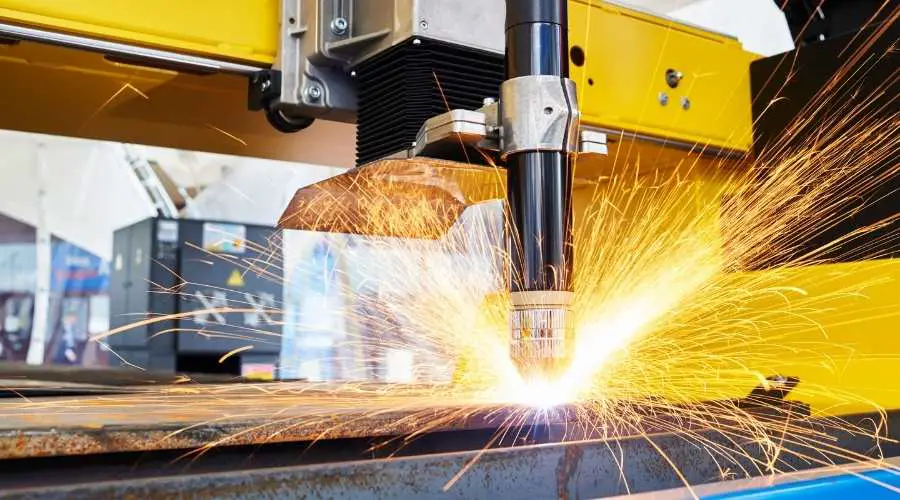When it comes to machining and manufacturing, laser cutting has become the go-to option for reliability and versatility.
Since lasers are easier to manipulate than cutting instruments (i.e., saws), manufacturers can create more intricate shapes. Also, the size and width of the laser can be adjusted for smaller, more detailed cuts.
Since laser cutting involves heating the material, it’s easy to assume that the laser itself gets hot. And, like others who are just getting into this hobby, the level and type of heat was one of my main concerns early on.
But how hot does a laser cutter get?
Actually, since lasers are made up of photons, not physical particles, they can’t heat up. Instead, cutting occurs because the energy is condensed into such a small space. For that reason, you can think of laser cutters as complex magnifying glasses, and the materials being cut as the ants.
So, with that in mind, let’s dive into this question and how it impacts the world of laser cutting.
How Hot is a Laser Cutter?
Technically speaking, a laser cutter isn’t hot at all. However, it heats and melts various materials (i.e., sheet metal) by condensing light energy into a small surface area.
Think of using a magnifying glass to burn wood or anthills.
The light itself isn’t hot because it’s made of photons, not physical particles.
Since laser cutters don’t get hot, they can operate at room temperature without adding any heat to the environment. No matter the type of laser cutter you use, none of them technically heat up.
Different Types of Laser Cutting
Although the act of cutting materials with lasers is pretty straightforward, there are three primary ways to do it: CO2, fiber, and crystal cutting. Let’s break down each option.
- CO2 Laser Cutting – These machines are the least powerful, with most devices ranging between 25 to 100 kilowatts. This cutter works by shooting an infrared laser through a gas mixture, which usually contains carbon dioxide, nitrogen, hydrogen, and helium. The width of the laser is 10.6 micrometers, making it ideal for softer materials like wood, plastic, and leather.
- Fiber Laser Cutting – This option is far superior to CO2 cutting because you get more precision and require less maintenance. For example, fiber cutters can last up to 25,000 hours between service visits. Best of all, you get more versatility without using much more electricity. The width of a fiber laser is 1.064 micrometers, so you can create intricate designs and shapes. Fiber lasers work best on metals and other hard surfaces. These lasers are also the most expensive of the three options.
- Crystal Laser Cutting – There are two options available for crystal laser cutting. The first is neodymium-doped yttrium aluminium garnet (nd:YAG) and the second is neodymium-doped yttrium ortho-vanadate, YVO4 (nd:YVO). The latter option works better than nd: YAG crystals because it delivers better cutting power and versatility. While crystal lasers can yield some incredible results, they’re also expensive and hard to maintain. The average machine only lasts up to 15,000 hours, and you have to replace pump diodes regularly. The main advantage of crystal lasers is that they work well for metals and non-metals, including wood or plastic.
Best Safety Practices When Laser Cutting
Although laser cutters technically don’t generate heat, they still burn the materials they’re cutting.
So, you need to be careful when working with these devices. Here are some general best practices when working with a laser cutter:
- Keep the Room Well-Ventilated – Some materials shouldn’t be laser cut, such as some plastics or epoxy resin. The reason to avoid cutting these materials is that they produce toxic gases. Even stable materials like wood or metal can create smoke and even small flames while working. So, you should have a vent hood over the laser cutter to prevent the buildup of potentially harmful emissions.
- Never Look at the Laser – Laser cutters use high-intensity beams. Even though the light itself may be invisible, it can produce brilliant flashes when they contact the material. You should also wear safety glasses to prevent the laser beam from damaging your eyeball.
- Keep Your Work Area Clean – Some materials can catch fire when heated with the laser. In some cases, excess debris can cause a fire in your workstation, damaging both your cutting material and the laser itself.
- Maintain a Dry Environment – Humidity can affect your machine’s cutting abilities. If the laser strikes water droplets in the air, it will refract. Sometimes, this refraction can lead to messy or disjointed cuts. In other cases, the laser may bounce back into the machine, damaging it.
- Never Touch Cutting Material Until It Has Cooled – Even if you’re trying to work quickly, you need to make sure your material is cool and safe to touch before removing it from the bed. Also, wearing gloves can help prevent burns, but moving the piece too soon could cause flaws and deformities.
The Bottom Line
Laser cutters technically don’t get hot. Instead, the material being cut can get pretty scalding if you’re working for extended periods.
So, while you might not have to worry about the laser generating heat, you still have to be careful when working with various materials, especially flammable ones.
Now that you’re armed with this information, you can be safe and efficient with your laser cutter. Happy cutting!

